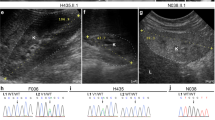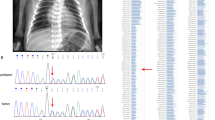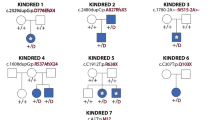Abstract
Alagille syndrome (AGS) is an autosomal-dominant disorder characterized by intrahepatic cholestasis and abnormalities of heart, eye and vertebrae, as well as a characteristic facial appearance. Identification of rare AGS patients with cytogenetic deletions has allowed mapping of the gene to 20p12. We have generated a cloned contig of the critical region and used fluorescent in situ hybridization on cells from patients with submicroscopic deletions to narrow the candidate region to only 250 kb. Within this region we identified JAG1, the human homologue of rat Jagged1, which encodes a ligand for the Notch receptor. Cell-cell Jagged/Notch interactions are known to be critical for determination of cell fates in early development, making this an attractive candidate gene for a developmental disorder in humans. Determining the complete exon–intron structure of JAG1 allowed detailed mutational analysis of DMA samples from non-deletion AGS patients, revealing three frame-shift mutations, two splice donor mutations and one mutation abolishing RNA expression from the altered allele. We conclude that AGS is caused by haploinsufficiency of JAG1.
This is a preview of subscription content, access via your institution
Access options
Subscribe to this journal
Receive 12 print issues and online access
$209.00 per year
only $17.42 per issue
Buy this article
- Purchase on Springer Link
- Instant access to full article PDF
Prices may be subject to local taxes which are calculated during checkout
Similar content being viewed by others
References
Alagille, D., Odievre, M., Gautier, M., Dommergues, J.P. Hepatic ductular hypoplasia associated with characteristic facies, vertebral malformations, retarded physical, mental and sexual development, and cardiac murmur. J. Pediatr. 86, 63–71 (1975).
Alagille, D. et al. Syndromic paucity of interlobular bile ducts (Alagille syndrome or arteriohepatic dysplasia): review of 80 cases. J. Pediatr. 110, 195–200 (1987).
Danks, D.M., Campbell, P.E., Jack, I., Rogers, J. & Smith, A.L. Studies of the aetiology of neonatal hepatitis and biliary atresia. Arch. Dis. Child 52, 360–367 (1977).
Dhorne-Pollet, S., Deleuze, J.F., Hadchouel, M. & Bonaiti-Pellie, C. Segregation analysis of Alagille syndrome. J. Med. Genet 31, 453–457 (1994).
Elmslie, F.V. et al. Alagille syndrome: family studies. J. Med. Genet. 32, 264–268 (1995).
Byrne, J.L., Harrod, M.J., Friedman, J.M. & Howard-Peebles, P.N. Del(20p) with manifestations of arteriohepatic dysplasia. Am. J. Med. Genet. 24, 673–678 (1986).
Anad, F. et al. Alagille syndrome and deletion of 20p. J. Med. Genet. 27, 729–737 (1990).
Legius, E. et al. Alagille syndrome (arteriohepatic dysplasia) and del(20)(p11.2). Am. J. Med. Genet. 35, 532–535 (1990).
Teebi, A.S., Murthy, D.S., Ismail, E.A. & Redha, A.A. Alagille syndrome with de novo del(20)(p11.2). Am. J. Med. Genet. 42, 35–38 (1992).
Deleuze, J.F., Hazan, J., Dhorne, S., Weissenbach, J. & Hadchouel, M. Mapping of microsatellite markers in the Alagille region and screening of microdeletions by genotyping 23 patients. Eur. J. Hum. Genet. 2, 185–190 (1994).
Hoi, F.A. et al. Localization of Alagille syndrome to 20p11.2-p12 by linkage analysis of a three-generation family. Hum. Genet. 95, 687–690 (1995).
Spinner, N.B. et al. Cytologically balanced t(2;20) in a two-generation family with Alagille syndrome: cytogenetic and molecular studies. Am. J. Hum. Genet. 55, 238–243 (1994).
Hattori, M. et al. Alagille syndrome with t(3;20)(q13.3;p12.2). Nippon Shonika Gakkai Zasshi 99, 1984–1986 (1995).
Spinner, N.B. et al. Defining the Alagille syndrome critical region on 20p using a translocation breakpoint and overlapping deletions. Am. J. Hum. Genet. 57, A35 (1995).
Krantz, I.D. et al. Investigation of SNAP-25 and PLCB4 as candidate genes for Alagille syndrome. Cytogenet. Cell. Genet. 74, 304–304 (1996).
Krantz, I.D. et al. Narrowing of the Alagille syndrome critical region and analysis of SNAP as a candidate gene. Am. J. Hum. Genet. 59, A224 (1996).
Pollet, N. et al. Construction of a 3.7-Mb physical map within human chromosome 20p12 ordering 18 markers in the Alagille syndrome locus. Genomics 27, 467–474 (1995).
Oda, T., Elkahloun, A.G., Meltzer, P.S. & Chandrasekharappa, S.C. Identification and cloning of the human homolog (JAG1) of the rat Jagged gene from the Alagille syndrome critical region at 20p12. Genomics (in the press).
Schnittger, S., Hofers, C., Heidemann, P., Beermann, F. & Hansmann, I. Molecular and cytogenetic analysis of an interstitial 20p deletion associated with syndromic intrahepatic ductular hypoplasia (Alagille syndrome). Hum. Genet. 83, 239–244 (1989).
Desmaze, C. et al. Screening of microdeletions of chromosome 20 in patients with Alagille syndrome.. j. Med. Genet. 29, 233–235 (1992).
Deleuze, J.F. et al. Deleted chromosome 20 from a patient with Alagille syndrome isolated in a cell hybrid through leucine transport selection: study of three candidate genes. Mamm. Genome. 5, 663–669 (1994).
Rand, E.B., Spinner, N.B., Piccoli, D.A., Whitington, P.F. & Taub, R. Molecular analysis of 24 Alagille syndrome families identifies a single submicroscopic deletion and further localizes the Alagille region within 20p 12. Am. J. Hum. Genet. 57, 1068–1073 (1995).
Li, L. et al. Alagille syndrome is caused by mutations in Jag1, a ligand for Notch1. Nat. Genet. 16, 243–251 (1997).
Spinner, N.B. et al. Mapping the Alagille syndrome critical region within 20p12. Proc. Single Chromosome 20 Workshop, February 1997, Hinxton, Cambridgeshire, UK Cytogenet. Cell. Genet. (in the press).
Heitzler, P. & Simpson, P. The choice of cell fate in the epidermis of Drosophila. Cell 64, 1083–1092 (1991).
Artavanis-Tsakonas, S., Matsuno, K. & Fortini, M.E. Notch signaling. Science 268, 225–232 (1995).
Nye, J.S. & Kopan, R. Developmental signaling. Vertebrate ligands for Notch. Curr. Bib. 5, 966–969 (1995).
Hunter, T. Oncoprotein networks. Cell 88, 333–346 (1997).
Ellisen, L.W. et al. TAN-1, the human homolog of the Drosophila notch gene, is broken by chromosomal translocations in T lymphoblastic neoplasms. Cell 66, 649–661 (1991).
Joutel, A. et al. Notch3 mutations in CADASIL, a hereditary adult-onset condition causing stroke and dementia. Nature 383, 707–710 (1996).
Lindsell, C.E., Shawber, C.J., Boulter, J. & Weinmaster, G. Jagged: a mammalian ligand that activates Notch1. Cell 80, 909–917 (1995).
Shawber, C.J., Boulter, J., Lindsell, C.E. & Weinmaster, G. Jagged2: A Serrate-like gene expressed during rat embryogenesis. Dev. Biol. 180, 370–376 (1996).
Lindsell, C.E., Boulter, J., diSibio, G., Gossler, A. & Weinmaster, G. Expression patterns of Jagged, Deltal, Notchl, Notch2, and Notch3 genes identify ligand-receptor pairesthat may function in neural development. Mol. Cell. Neurosci. 8, 14–27 (1996).
Bao, Z.Z. & Cepko, C.L. The expression and function of Notch pathway genes in the developing rat eye. J. Neurosci. 17, 1425–1434 (1997).
Garrod, A. The lessons of rare maladies. Lancet. 1, 1055–1066 (1928).
Elkahloun, A.G., Bittner, M., Hoskins, K., Gemmill, R. & Meltzer, P.S. Molecular cytogenetic characterization and physical mapping of 12q13-15 amplification in human cancers. Genes. Chromosomes. Cancer 17, 205–214 (1996).
Beaudet, A.L. & Tsui, L.-C. A suggested nomenclature for designating mutations. Hum. Mutat. 2, 245–248 (1993).
Author information
Authors and Affiliations
Corresponding author
Rights and permissions
About this article
Cite this article
Oda, T., Elkahloun, A., Pike, B. et al. Mutations in the human Jagged1 gene are responsible for Alagille syndrome. Nat Genet 16, 235–242 (1997). https://doi.org/10.1038/ng0797-235
Received:
Accepted:
Issue Date:
DOI: https://doi.org/10.1038/ng0797-235



